Personal Hall of Fame, Part 6: Filling in the Gaps
Mar 12, 2013 by Adam Darowski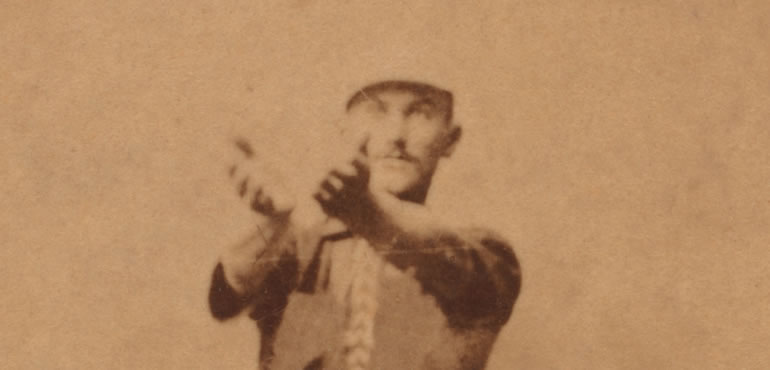
In the first five parts of this series (Part 1, Part 2, Part 3, Part 4, and Part 5), I named 200 players to my Personal Hall of Fame. It turns out, this has become a bigger project, with fellow friends and bloggers Dan McCloskey, Ross Carey, Bryan O’Connor, and Graham Womack taking part. Each is working on his own Personal Hall of Fame, which we’ll then compare, combine, and use to debate players we have yet to agree on.
Before that, I’d been meaning to analyze my Top 200 a bit more. While I don’t feel that every position and era (and combination of the two) needs to be equally represented in a Hall of Fame, I do feel that any glaring holes should be analyzed. That’s what I’m going to do today. I created a visual that shows my 200 initial choices mapped on a timeline, sorted by position. Let’s take a look, position by position.
I’m going to skip over the pitchers because the graphic is so large and there seems to be a good amount represented from each era.
Catchers
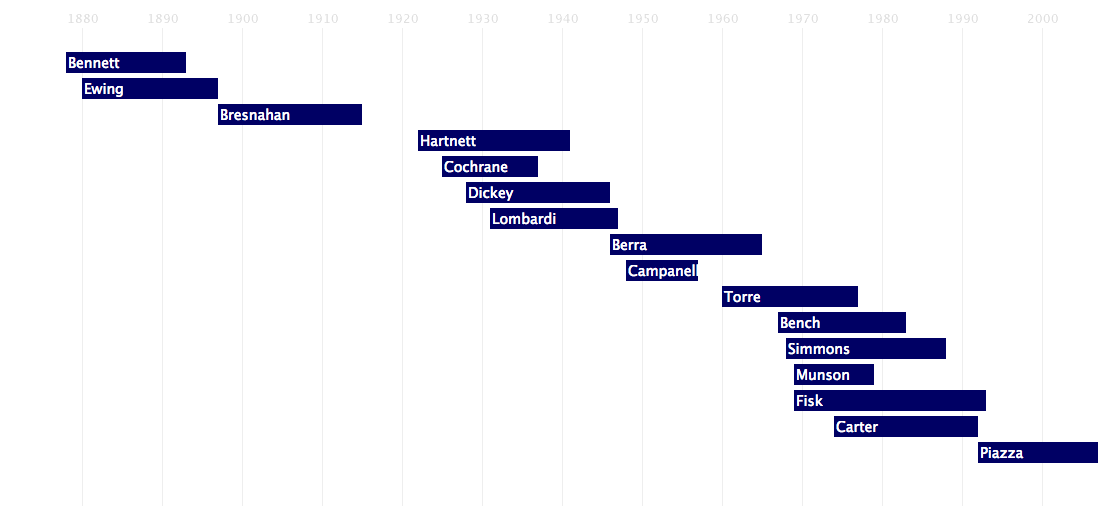
Perhaps the best 19th century catcher isn’t shown here because he played more often at third base (Deacon White). Otherwise, we don’t really have any large gaps, per se. But there are a couple light areas.
- 1890–1930 is essentially taken up by Roger Bresnahan. Bresnahan isn’t in the Hall of Stats, but his dominance during this forty year period makes him an easy choice for my Personal Hall. The Hall of Fame, the Hall of Stats, and my Personal Hall (so far) excludes the catcher who actually had the highest WAR during this stretch: Wally Schang. Schang is a tremendously underrated receiver who posted a 120 wRC+, 41.4 WAR, and a Hall Rating of 92. Schang even won three World Series rings (with three different teams). Should he be in my Personal Hall? He’s one I think about often.
- 1945–1970 is taken up by Yogi Berra and the brief career of Roy Campanella. 1970 kicked off a Golden Era for catchers, but the three decades before are light. There aren’t really any compelling players to add, however. Berra and Campanella lead the way in WAR with the first part of Joe Torre’s career next. After that, it’s Smoky Burgess. Burgess was a solid player, but certainly not a Hall of Famer.
First Basemen
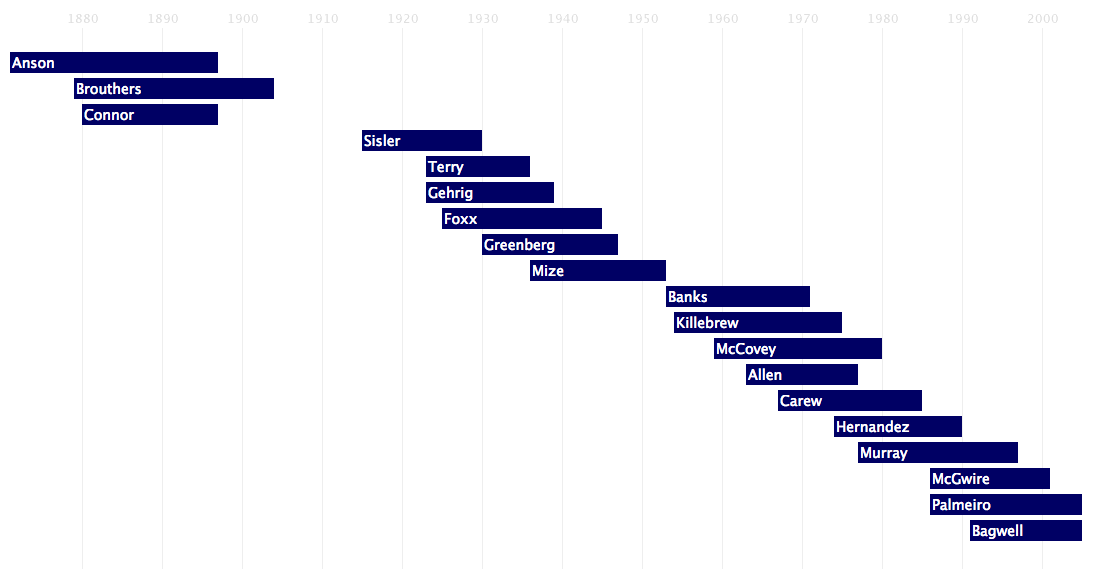
First base is relatively stacked, but we have a few players here who played significant portions of their careers elsewhere (like Rod Carew, Ernie Banks, Dick Allen, and Harmon Killebrew).
- 1890–1920 is a pretty big gap. Jake Beckley is in the Hall of Fame, the Hall of Stats, and the Hall of Merit. He was also the most valuable first baseman over this stretch, so I should really reconsider his omission from my Personal Hall. Still, his 57.1 WAR is a modest total to lead a position for that long a stretch—especially first base. The runner-up is Frank Chance, a player I would consider adding for his combined role (he was a very successful manager), but not just for his playing career.
Second Basemen
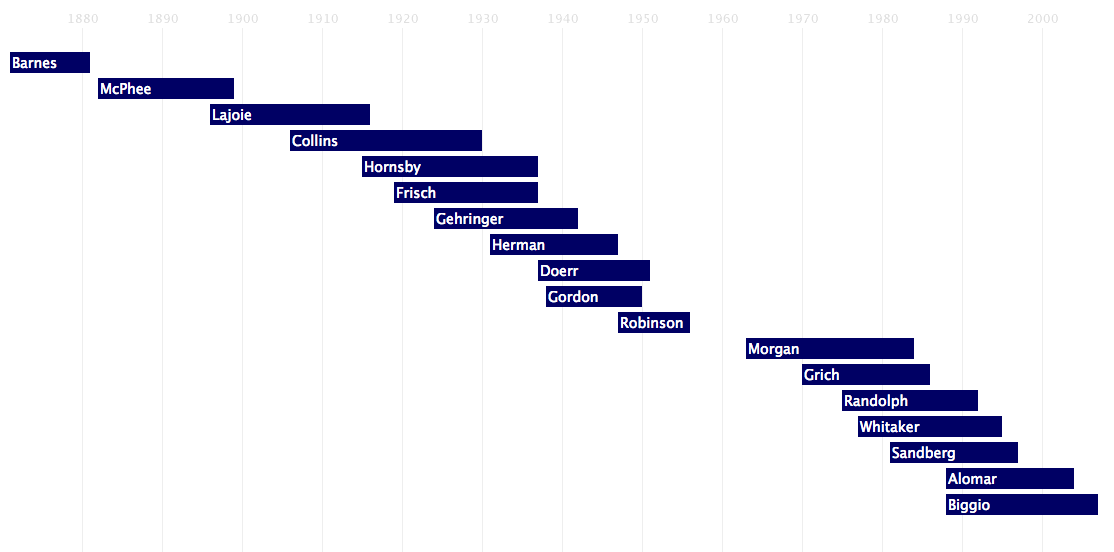
This exercise is not just to seek players I should enshrine, but also to justify some I did pick. If I were to rank my 200 choices, Bid McPhee and Ross Barnes would be near the bottom. But as you can see here, they really help fill the 19th century gap well. Their main competition comes from Cupid Childs (85 Hall Rating) and Fred Dunlap (72 Hall Rating). Good players, but I’ll take McPhee (95 Hall Rating) and Barnes (87 Hall Rating in nine seasons). There is one gap, however:
- 1950–1970 covers the bulk of Jackie Robinson’s career and the beginning of Joe Morgan’s. Granted, this isn’t a huge gap, but we do have a few years without a (Personal) Hall of Fame second baseman. That gap is best filled by Nellie Fox, a player I was very close to putting in. So, while there isn’t an urgency to fill this gap, it’s interesting that it would be filled by the second baseman that I nearly put in.
Third Basemen
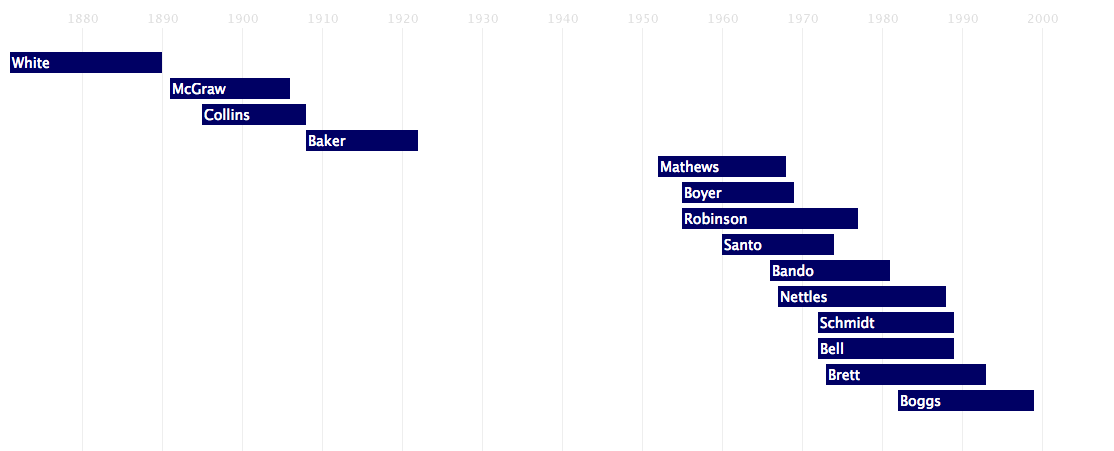
Third base is a hot mess. The Hall of Fame doesn’t have many. I’m not doing any better, picking only fourteen so far. Ten of them played after Eddie Mathews debuted in 1952. From 1871 to 1951, I have just four. One (White) should probably be considered a catcher. One barely squeezes into the Hall of Stats (Jimmy Collins). One is in the Hall of Fame, but as a manager (John McGraw). The last is Home Run Baker. From Baker’s retirement until Mathews’ debut, we have an enormous gap with absolutely nobody.
- That 1920–1950 gap is led by Stan Hack, a player who is getting harder and harder to leave out. Smiling Stan was a solid leadoff man for the Cubs, hitting .301 with a .394 OBP (124 wRC+). He had 50.7 WAR and a Hall Rating of 94. The only reason I haven’t put him in is that it would make it difficult to leave Heinie Groh out. Groh played a bit before Hack, but was similarly valuable (122 wRC+, 46.3 WAR, 93 Hall Rating). Should both be in? Neither? I’m having a hard time with both of them.
- If White is considered a catcher and McGraw is left out, who would the next-best 19th century third baseman be? You’re looking at Ed Williamson (80 Hall Rating), Denny Lyons (74), or Ezra Sutton (73).
Beyond the players mentioned above, pre-1950 third sackers include Larry Gardner, Bob Elliott, Lave Cross, and Harlond Clift. I’m not ready to put any of them into my Hall.
Shortstops
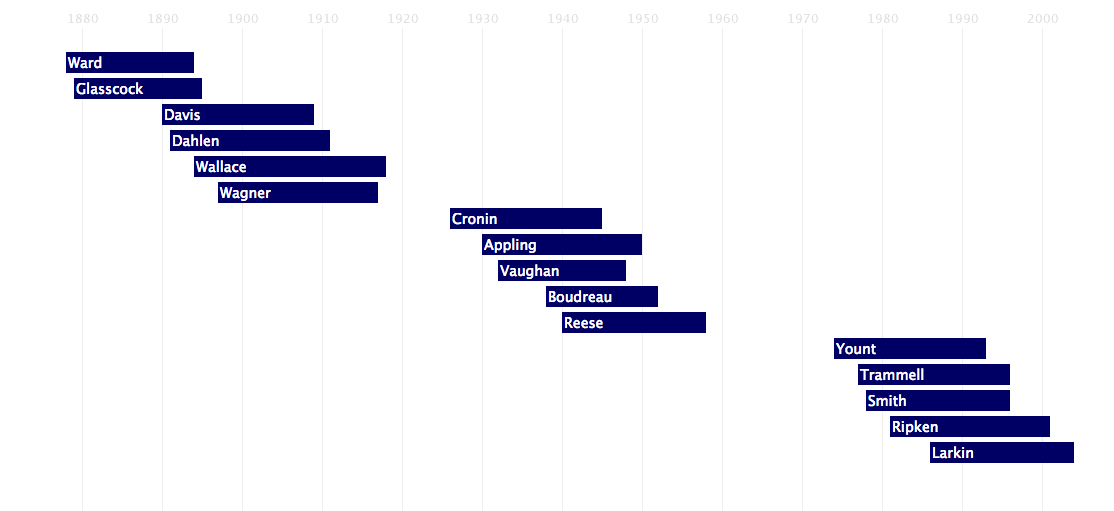
Shortstop is interesting, with all sixteen inductees bunched up in three clumps. That leaves some small gaps to analyze:
- 1915–1935 is led by Joe Sewell, Dave Bancroft, and Travis Jackson. We have a couple Frisch (or in the case of Jackson, perhaps Frisch-inspired) picks here. Bancroft is often lumped in with the terrible Frisch picks, but I don’t think he’s necessarily a bad pick. He was likely my toughest shortstop to omit. For some reason, I have never taken Sewell seriously. The fact that he leads this (small) stretch should make me look again. He was a better hitter than Bancroft, with 149.9 batting runs to Bancroft’s 15.6. Bancroft takes the edge back in defense, however. So, should both be in? Perhaps neither? It’s a small enough gap that I don’t need to worry about it too much.
- 1950–1980 is similarly light. This era is led by Luis Aparicio, another who was difficult to omit. Aparicio could not hit. But boy could he field and run the bases. The fact that a ton of Gold Gloves and All Star selections were bestowed on him is worth something. Next best on the list is Bert Campaneris, who received some accolades, but nowhere near Aparicio.
- I’m a huge Jack Glasscock supporter. Not many are. The only other 19th century shorstop is John Ward, who could be considered a pitcher. So, who else is there? Next is Hughie Jennings. I don’t love him as a Hall of Fame player. Maybe for a combined role. I mean, he managed Cobb. That’s worth something, right?
Left Fielders
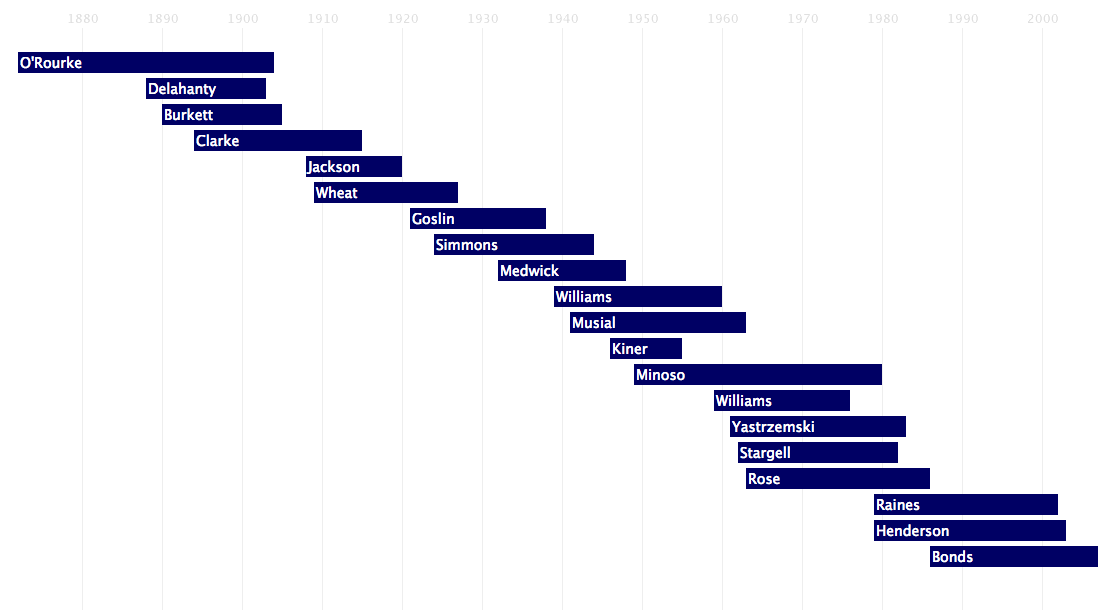
Honestly, this couldn’t look better. But there are still several left fielders I wanted to include. Those include Sherry Magee (one who’s very hard to keep out) and 19th century stars Harry Stovey and Pete Browning.
Center Fielders
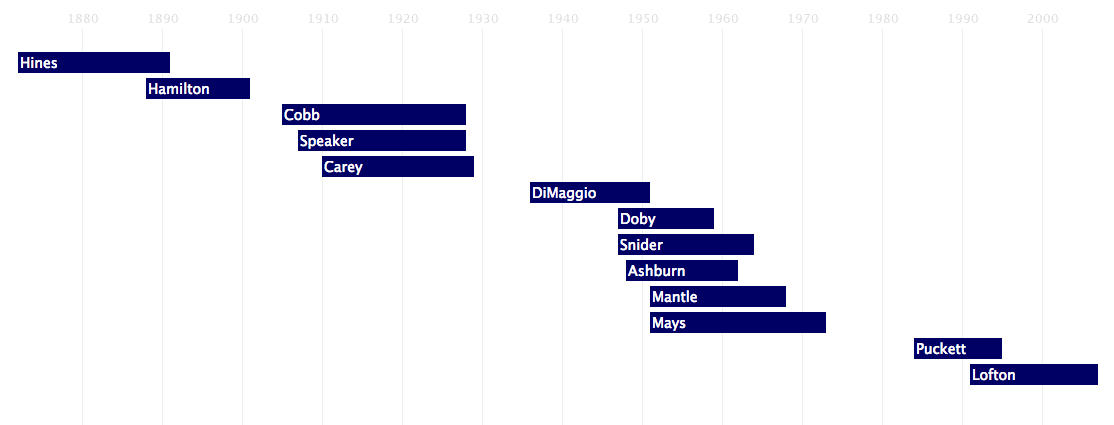
This helps justify my inclusion of Paul Hines a bit. Center field is my least populated position, so there are certainly some gaps here.
- 1930–1950 doesn’t feature much outside of Joe DiMaggio. Next is Earl Averill, but I’m not compelled to support him. Solid hitter, but in a hitter’s era. And he didn’t play long or provide much value elsewhere.
- 1970–present is very light (except for Kirby Puckett and the one-and-done Kenny Lofton). There are several compelling center fielders from the era who are either not yet eligible (Ken Griffey Jr. and Jim Edmonds) or still active (Carlos Beltran and Andruw Jones). Besides that, we’re looking at Johnny Damon, Chet Lemon, and César Cedeño. I’ll put Griffey, Edmonds, Beltran, and maybe Jones in, so I’m not worried about other additions.
- If I didn’t include Hines, that would leave only Billy Hamilton before 1910. Who else is there? Fielder Jones and George Van Haltren are next. Neither really appeals to me.
Right Fielders
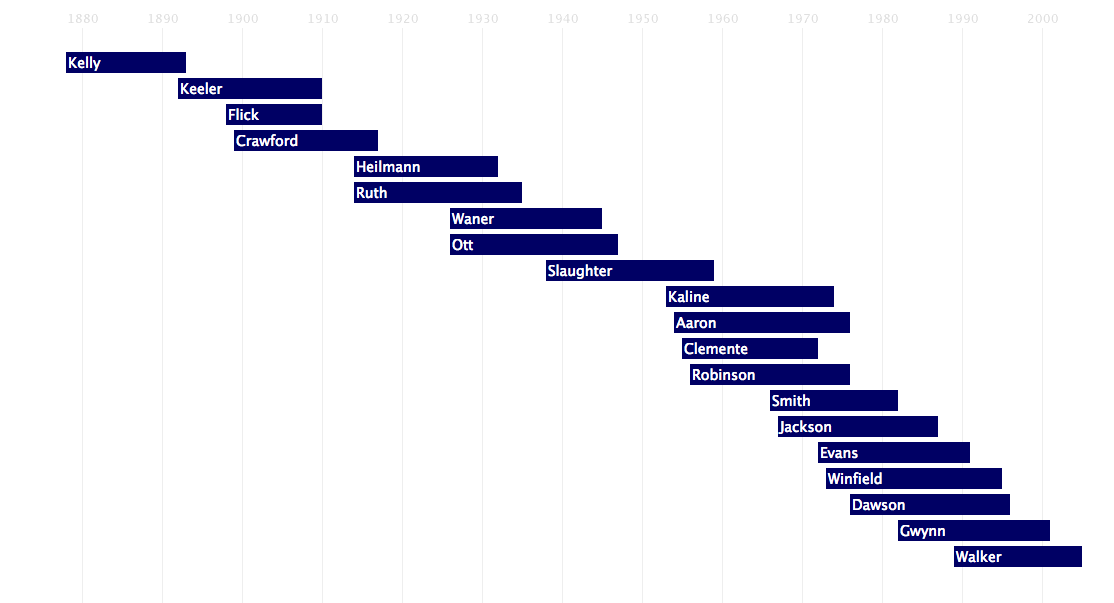
Right field actually has a very nice progression, much like left field. There aren’t any noticeable gaps, but it is noticeable that the post-1955 era is represented much more. Part of this can be attributed to expansion. But I don’t think that covers all of it.
- Pre-1955 right fielders that I haven’t included are Harry Hooper, Sam Rice, Sam Thompson, and Chuck Klein. I agonized over Thompson and Klein, since their raw numbers were remarkable. They were aided quite a bit by park effects, though. Hooper has a Hall Rating of 82 while Rice was a 79. I’m far more inclined to take Thompson and Klein, who were higher-peak players.
- I’m really glad I included Willie Keeler and Elmer Flick, as I wasn’t sure about including them. Turns out, they rank quite highly.
Should I Reconsider?
Here are the players I identified as possible additions after this exercise:
- C Wally Schang
- 1B Jake Beckley
- 1B Frank Chance
- 2B Nellie Fox
- 3B Stan Hack
- 3B Heinie Groh
- SS Joe Sewell
- SS Dave Bancroft
- SS Luis Aparicio
- RF Sam Thompson
- RF Chuck Klein
Add to that group some of the players I still go back and forth on:
- P Jim McCormick
- P Tony Mullane
- P Wilbur Wood
- P Billy Pierce
- P Nap Rucker
- P Noodles Hahn
- C Gene Tenace
- C Bill Freehan
- 3B Darrell Evans
- SS Joe Tinker
- LF Harry Stovey
- LF Pete Browning
- LF Sherry Magee
- CF Jim Wynn
- RF Bobby Bonds
I mean, I could still put them all in and have just a 226 person Hall. I’ll admit—that’s not a terrible idea. Your thoughts?